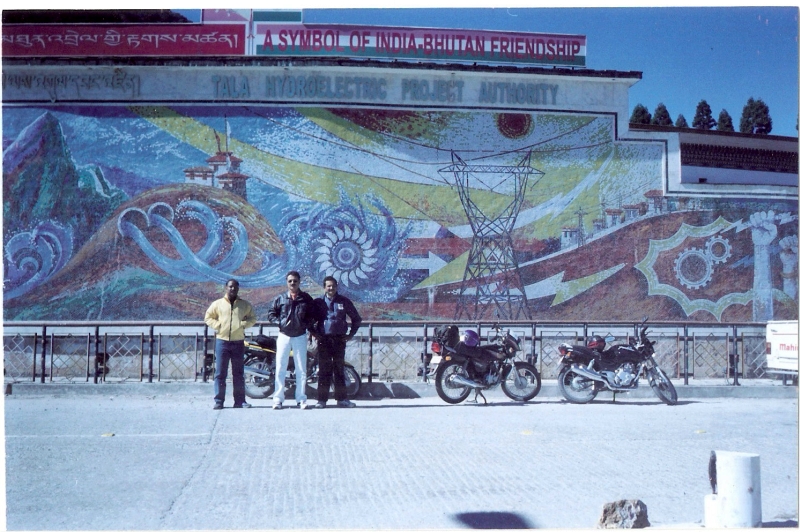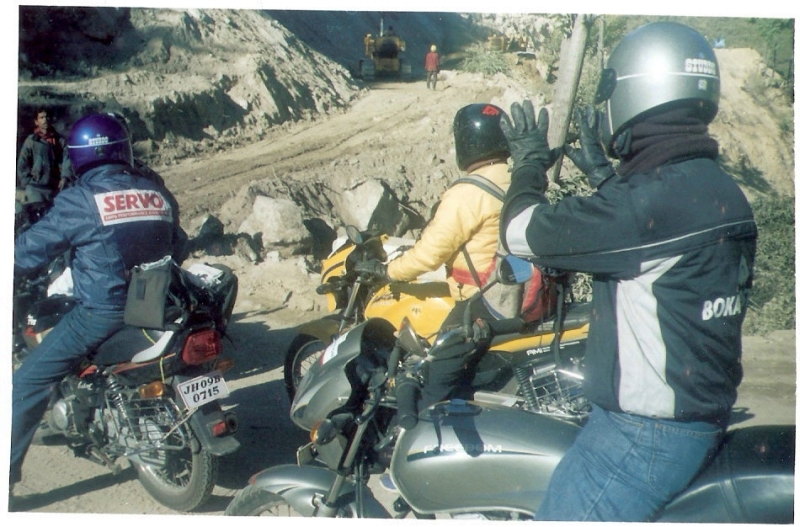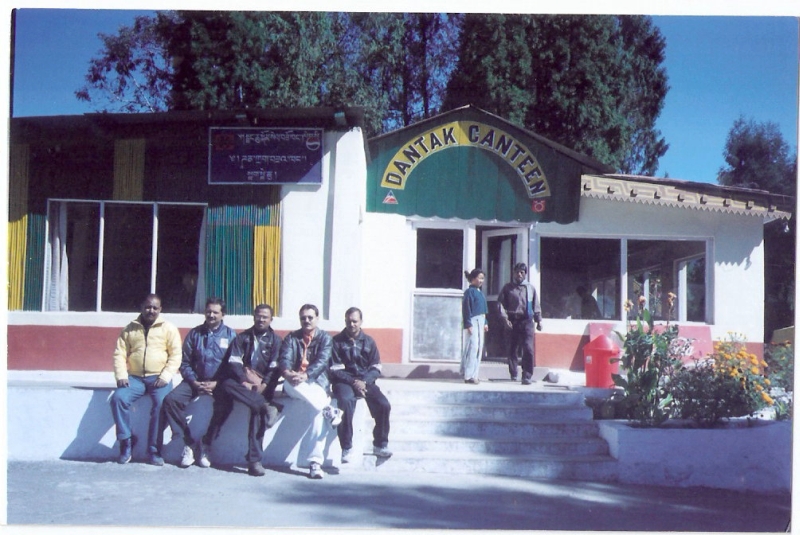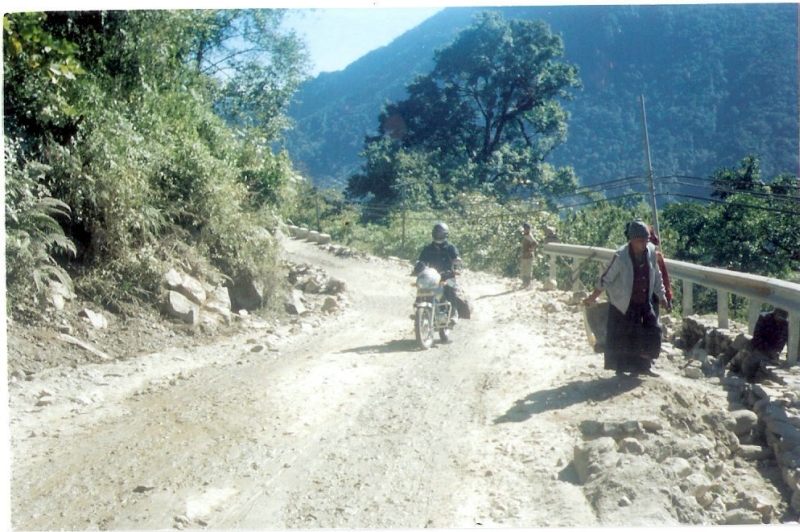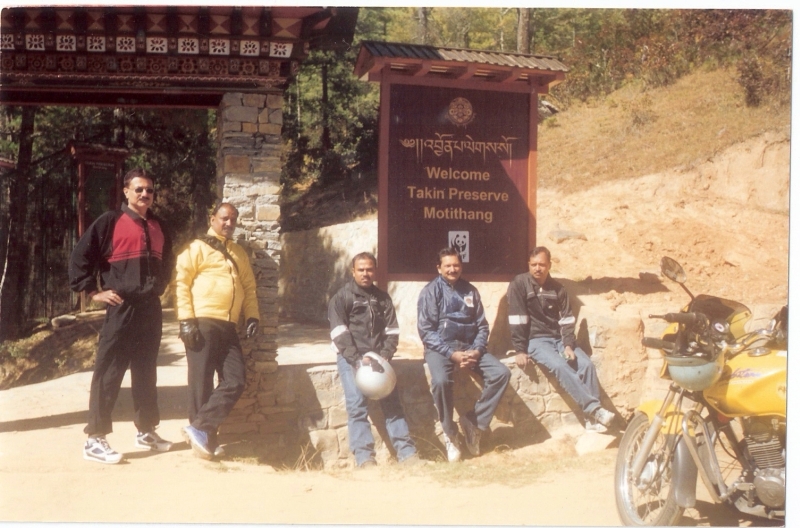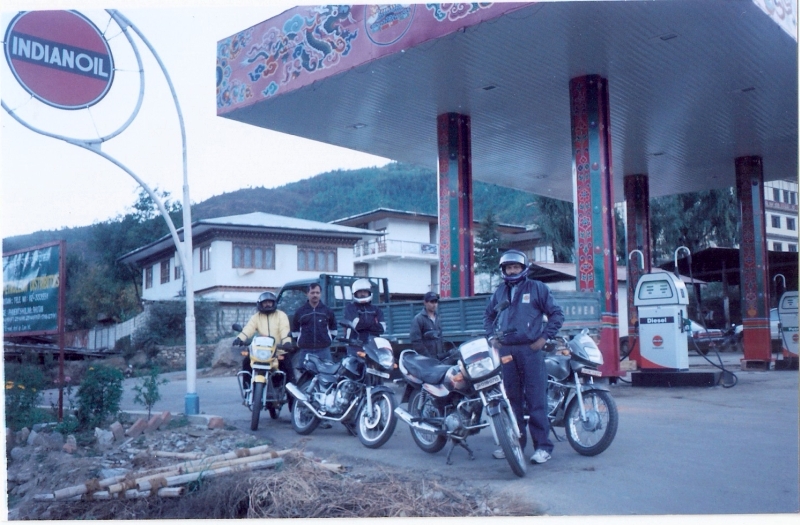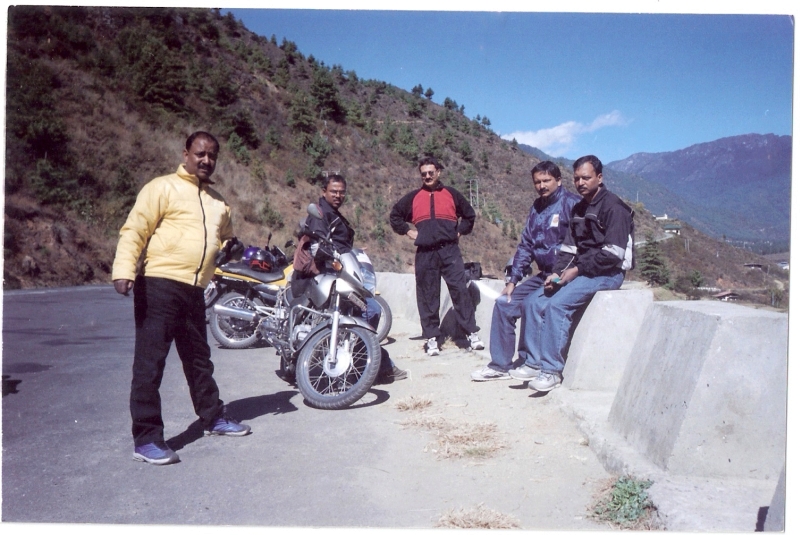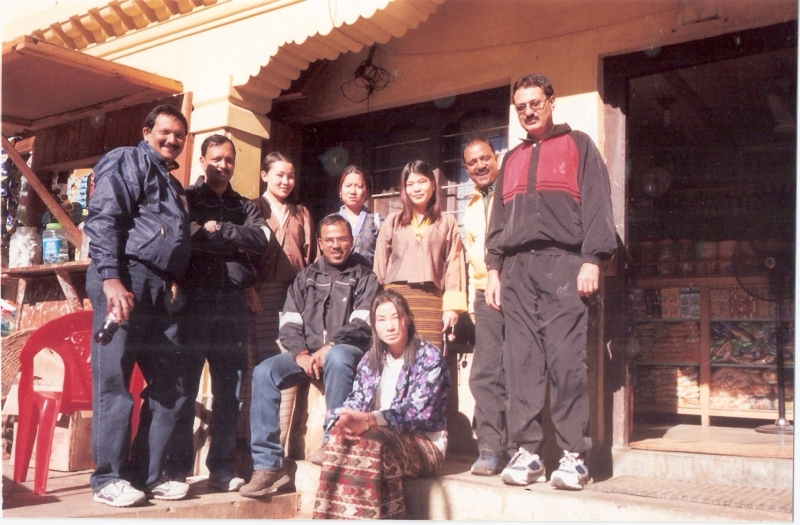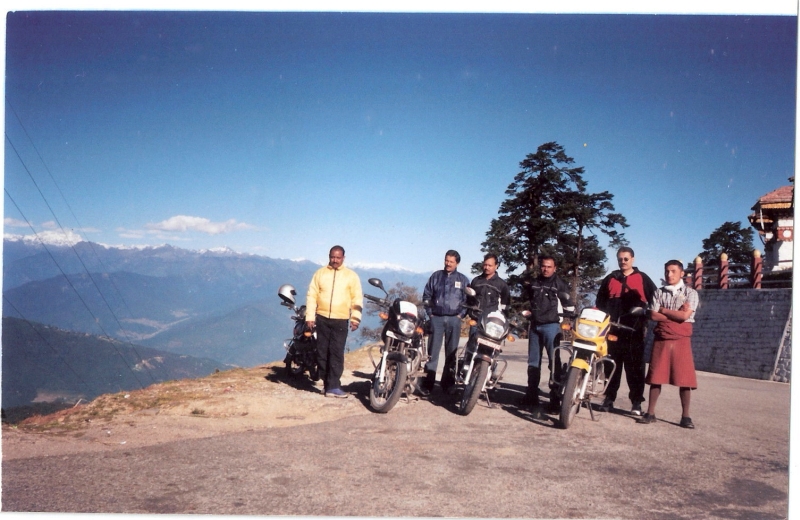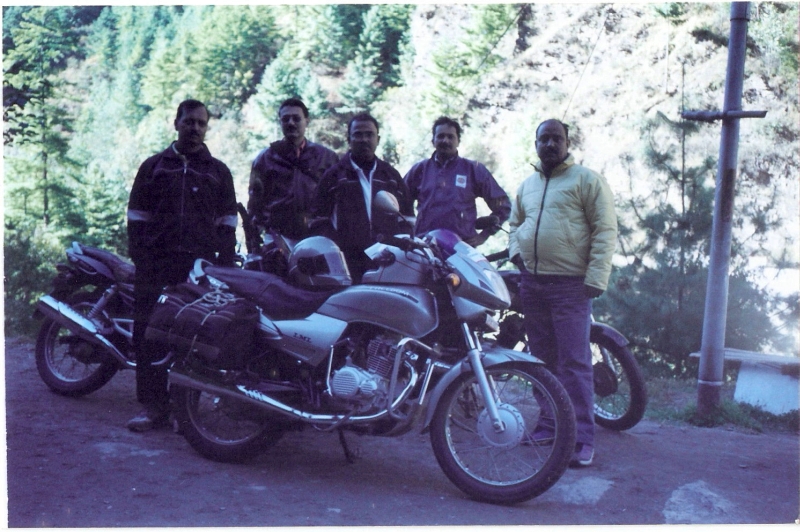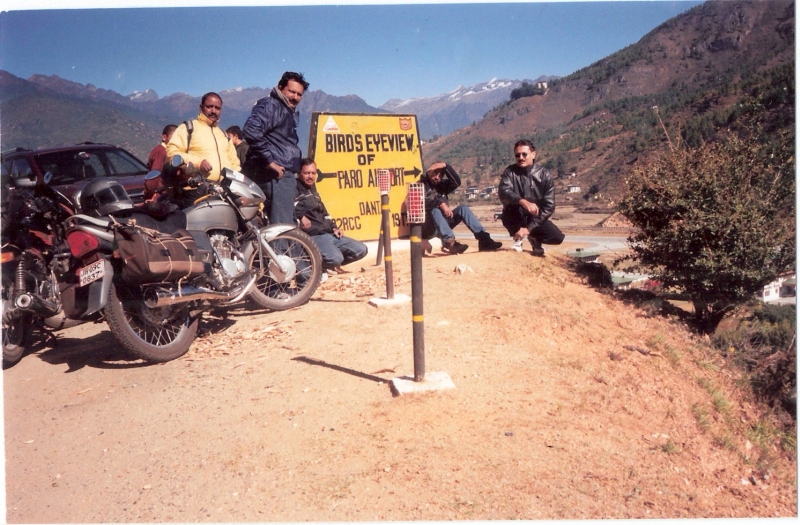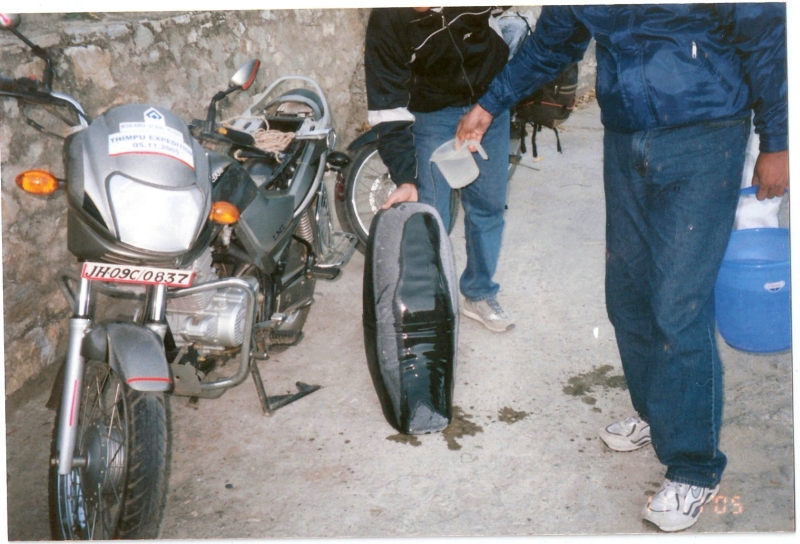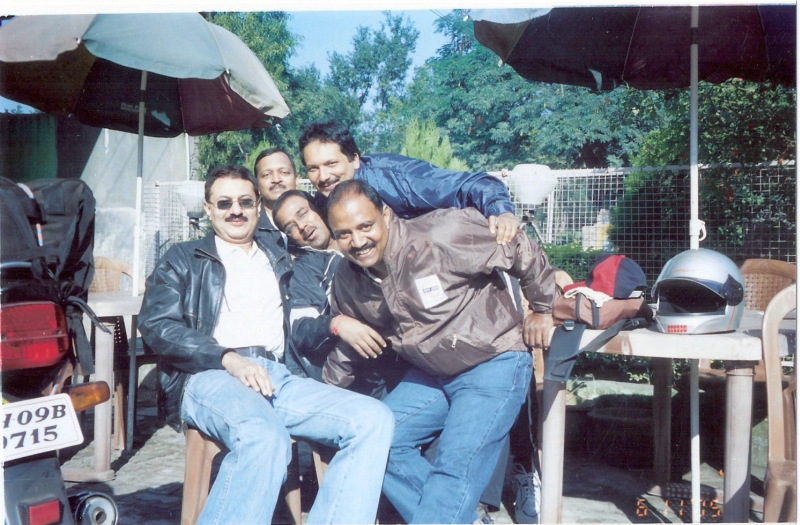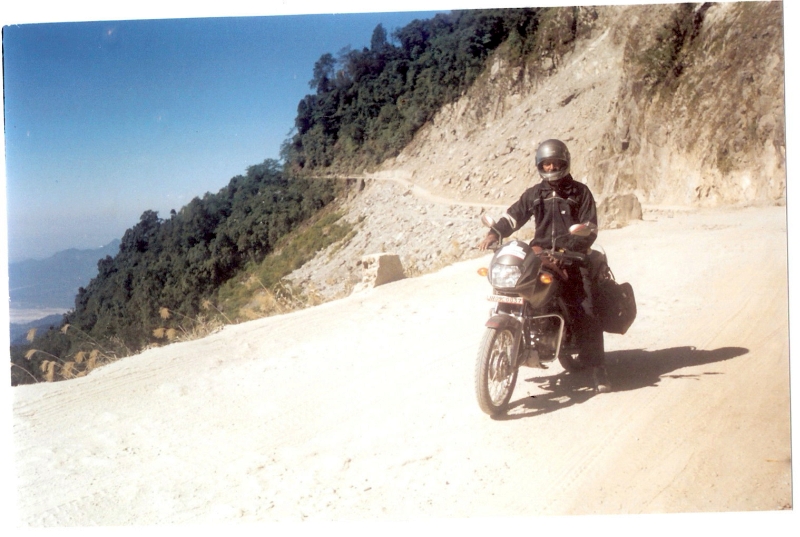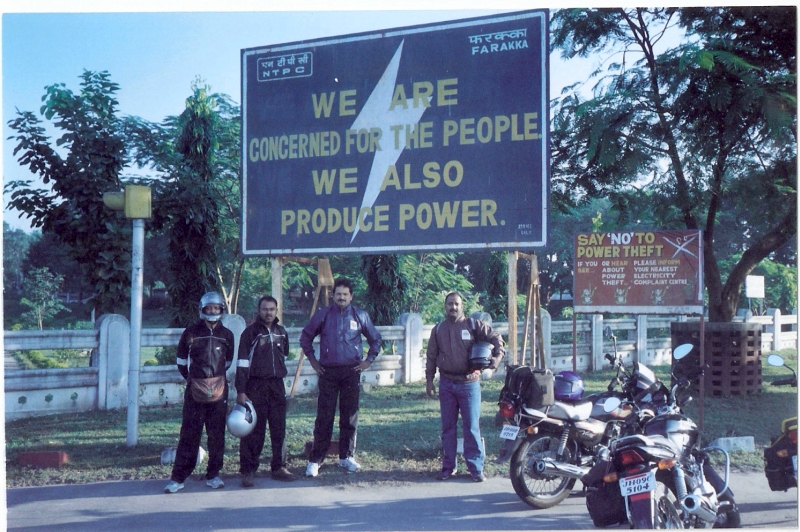It was way back on one cold day in the month of December when five of us not-so-young-not-so-old men decided on a bike expedition to Bhutan – the land of the thunder dragon. When we started floating the idea of India to Bhutan bike trip around, people questioned us as to what was the purpose of embarking on a tough expedition such as this?
Well, we presume that our esteemed readers might also be thinking on the same lines. I found this quote by Sir Richard Burton to aptly justify the idea and answer the question.
One of the gladdest moments of human life, methinks, is the departure upon a distant journey into unknown lands. Shaking off with one mighty effort the fetters of habit, the leaden weight of routine, the cloak of many cares, and the slavery of home, man feels once happier. (Sir Richard Burton)
Broadening our horizon, meeting new people, getting to learn of traditions, customs and social set-up of an unknown land by being right there amongst them, endorsement of friendly relations between the two countries, being ambassadors of our organization, enriching of team spirit and achieving set goals – to name just a few, were the driving force for all of us.
That is why we decided on an India to Bhutan Bike trip. Explore, Dream, Discover – with these in mind we set out on preparations for the expedition.
Quick Navigation
India to Bhutan Bike Trip Travelogue
But why of all places Bhutan? It was mainly because nestled high in the Himalayan mountains, this small monarchy represents one of the world’s most remote and least visited lands.
Closed to the outside world until 1974, Bhutan was accessible only by narrow mountain trails and that only by special invitation of the government. Today, a modern road connects the capital city Thimphu with Phuentsholing, Bhutan’s border town on the plains.
The national carrier, Druk Air, is the only airline allowed into the country and requires its pilots to undergo specialized mountain flight training.
Our proposal got the support and encouragement from SAIL management and on approaching Indian Oil Corporation for assistance; we were delighted to get the same by way of IOC chipping in by sponsoring fuel costs. And, the expedition was well on its way.
Also Read: Road Trip to Bhutan – Journey of a Lifetime
Day 1: Bokaro Steel City to Farakka
The sun was out and shining on 5th Nov morning when the expedition was flagged off, after having customary and auspicious ‘laddoos’, by DGM (I/C)-S & CA and other officials from the premises of Sports Complex, Bokaro Steel City at 8:15 a.m. Our India to Bhutan bike trip had officially started.
All of us were geared up, excited, and enthusiastically looking forward to the trip. Bikes had been spruced up, fuel tanks filled to the brim, and all nitty-gritty was taken well care of. We drove to Dhanbad and took the famous GT Road at Govindpur.
Driving on the four-lane GT Road is a pleasure. Asansol and Durgapur passed by in a jiffy. After driving for 118 km from Dhanbad, we took to the left at Darjeeling More, just 3 km before Panagarh. The road was broad and except for a few potholes that cropped up time and again, the ride was smooth and enjoyable.
At Siuri, all of us stopped for lunch. After lunch and a 30 min break we were back on our bikes and reached Moregram on the Darjeeling Highway- NH 34 via Rampurhat. And it was then that all our driving skills were put to test. The road was weather-beaten in most of the parts due to the incessant rains the area had witnessed all through October. Large potholes made driving tough.
Approaching Farakka
To top it all, there were endless rows of buses and trucks. Getting forced out of the roads by overtaking North Bengal State Road Transport Corporation buses, whose drivers felt that the only obligation they had towards we poor people on bikes, was getting their headlights on and driving through as if we never existed!!
It was only then that we realized how bad traffic on Indian highways can be and in a way, it also prepared us for what was to be expected later on in the expedition. The nightmare had only started. But surely, these hindrances in no way dampened our spirits and we inched our way forward.
By the time we reached Farakka, it had already grown dark, and glaring headlights of oncoming traffic, coupled with the bad road added to our woes. We drove to the NTPC Guest House at Farakka and were lucky enough to get accommodation. A warm bath took away some of the fatigue. Dinner followed and exhausted as we were, soon fell asleep like dead logs.
Also Read: Thrumshing La – The High Roads and Passes of Bhutan
Day 2: Farakka to Siliguri
Early next morning, afresh from a good night’s sleep, the team was back on course and took the NH-34 towards our next goal –Siliguri. There was a slight breeze and though the sun was out, it was not so hot. What really was irksome was that the road condition had changed for the worse.
It was now a bumpy dirt track with potholes as large as our bikes themselves. Traffic had grown heavier and the dust hurled up by buses and trucks whirled up in big clouds, engulfing our bikes and bodies and started getting into our eyes. The thought that the road will improve egged us on, despite our exhaustion.
Our prayers were soon answered when things brightened up quite a bit after Malda – the land of mangoes. After driving for about 4 hours we treated ourselves to some fresh pineapple juice right from the fields adjacent to the road. Refreshed after having a good fill and taking a few minutes of a break, we drove on towards Dalkhola.
Approaching Siliguri
From Dalkhola the highway forms part of the prestigious PM’s 4-lane golden quadrilateral east-west project. The four-lane work has been completed on the Dalkhola-Islampur section and driving on the road was like sliding on butter. It was time to get our bikes to perform and make up for the lost time.
And perform they did. Ved’s Pulsar and Ashesh’s Ambition were out of sight in a jiffy, followed by Saravan & Arun on the Freedom and yours truly on the Victor. We stopped by at a dhaba for lunch. The food was quite good and the ‘khatias’ provided looked tempting and inviting.
But there was no time to lose as we had still some distance to cover to get to Siliguri. It was around 5:00 pm when we entered Siliguri city. A couple of team members scouted for some decent hotel and having found one, we called it a day.
Also Read: Delhi to Bhutan Bike Trip – Fun & Adventure
Day 3: Siliguri to Phuentsholing
Day-3 started at 7:00 a.m. Re-fuelling the machines was done at the Indian Oil Outlet at Siliguri. And soon the team was on its way on the third leg of the journey towards the border town of Phuentsholing in Bhutan.
We turned right at Sevoke and crossed the Coronation Bridge to take the Gauhati road. The road was quite good and passed through picturesque tea gardens with the lower Himalayan ranges in the backdrop. Traffic was sparse and driving blissful and enjoyable.
All terrible and harmful effects that our bodies might have had gone through by gulping in the polluted air in the form of vehicular emissions during the first two days seemed to have got defused by the refreshingly clean and oxygen-enriched air of the tea gardens. We took brief stop-overs at Jaldapara and the Mahananda wildlife sanctuaries, famous for the one-horned Rhinoceros.
Entering Bhutan
We left the Gauhati highway at Hasimara and took the left turn for Jaigaon, which is the town on the Indian side of the border. The team reached Phuentsholing around 2:00 pm after covering about 180 km. Finally, we were on foreign land.
The cultural difference manifested itself through two distinct factors – change in dress and language apart from the physical features of the Bhutanese citizens. Five Indian guys on four bikes – people stared at us as if we were from some different planet altogether!!
As special permits are required for foreigners for the onward journey to Thimphu and Paro, we decided to skip lunch and straightway got into the business of getting these made. Our quest took us to the India House Liaison Office, Bhutan Immigration Office, and the Transport Office.
We really had to put all our PR skills to task to get the Entry Permits and Vehicle Permits made for the onward journey to Thimphu and Paro. The helter-skelter left us physically exhausted, but we were amply rewarded when by evening all our permits were in hand.
We retired for the night quite early at Hotel Kuenga, as we were tired of running around Phuentsholing for getting the permits made and also a bit apprehensive about driving on Himalayan roads the next day.
Also Read: Bike Trip to Bhutan – Bike Ride to Bhutan from Delhi
Day 4: Phuentsholing to Thimphu
Day 4 was a new experience for all of us. We knew that riding in the Himalayas wouldn’t in any way be easy. A bus driver we befriended at Phuentsholing had advised us to be prepared for the cold up there as well as for the narrow and winding road.
We equipped ourselves physically by putting on our woolens and jackets and prepared mentally for situations to be faced ahead since we had no prior experience of driving in such conditions. Finally, we started for our final destination.
The gradient was steep and bends and turns blind. The road was treacherous and driving dangerous. On one side were deep gorges and on the other side the mighty mountain slopes. The bikes were put to test and luckily the machines delivered what was expected of them.
Taking all safety precautions, carefully negotiating each turn – some of them being acute angle turns (elbow), we slowly inched our way uphill, as each kilometer seemed to stretch forever. There were certain sections on the highway where the sun has no access to throughout the year and driving through them on bikes was chilly and shivering.
Roads of Bhutan
The roads in Bhutan are maintained by 60 Road Construction Company (Dantak) – a unit of the Indian Army and are quite good. We marveled at the sight of the impressive mountains but were careful enough not to get too carried away, as one small careless maneuver could hurl us deep down the slopes into oblivion.
Nevertheless, we did imbibe the soaring peaks, densely forested hills, and Bhutan’s exotic flora which included rhododendrons, junipers, and magnolias several meters high, carnivorous plants, rare orchids, blue poppy (national flower), edelweiss, gentian, medicinal plants, daphne, giant rhubarb, high-altitude plants, tropical trees, pine, and oak. Occasionally we also got to see the Golden Langurs, hornbills, pheasants, mountain goats, and timid blue sheep.
The Dantak unit has a lovely little canteen nestled snugly at a vantage point on the highway and we stopped over for some delicious and hot Indian food in the form of ‘dal’-‘chawal’. We took an hour’s break, enjoying the terrain and clicking snaps.
Off again after the sumptuous lunch, we reached Chukha Hydroelectric Project and later passed by the upcoming Tala Hydroelectric project -both symbols of Indo-Bhutanese Friendship.
En route we were greeted by school-going Bhutanese children having apple-colored cheeks who waved at us and counted ‘one-two-three-four’, as if we were part of some Himalayan Bike Rally. Saravan and Arun could not resist their charms and stopped over a couple of times to get their snaps and have small interactions.
Thimphu
Unfortunately, we got caught in a roadblock around 3:00 p.m. as the double-lane work of the road is under execution by ‘Dantak’. Thimphu was still some 35 odd km away. The road was opened only at 5:00 pm, and by that time it had grown dark and cold.
Now we had to make use of all our driving skills, as night driving on that narrow road with oncoming traffic to handle, proved challenging. With God’s grace, all of us reached Thimphu safely at 7:00 pm and put up at Hotel LT, Thimphu Central, after some exploration for a decent one not too heavy on our pockets.
Also Read: Bhutan – From the Eyes of a 12-Year-Old
Day 5: Sightseeing in Thimphu
We got up early the next morning and had our first glimpse of the capital city of Thimphu. It was only then that the realization that we actually made it started to sink in. We found that Thimphu is nestled in a narrow valley and surrounded by high mountains, some of them having snow-covered peaks. It was a cold day in Thimphu.
Earlier in the evening, we had hired the services of a local guide – Mr. Pashang, a young gentleman of 21 years to show us around and make sure that we don’t violate the traffic rules and get fined. Fines for traffic violations are heavy in Thimphu with many roads being one-ways.
We got ready and went to the parking lot only to discover that our bikes were covered with a half-an-inch layer of ice. The sun was by that time out and shining and it was not long before the ice gave way to our spirit of exploring in and around Thimphu.
Bhutan Broadcasting Service
We drove to the top of a small mountain, which houses the tower of the Bhutan Broadcasting Service, for a bird’s eye view of Thimphu. We then visited the Indian Embassy – INDIA HOUSE and were fortunate to meet the First Secretary (Eco) – Dr. T.V. Nagendra Prasad.
He was happy to learn about our mission and apprised us of some facts and figures of Bhutan and how the country was of strategic importance for us. In turn, we acquainted him with our organization and Bokaro Steel Plant.
After our visit to INDIA HOUSE, Mr. Pashang took us to a very beautiful place called ‘Dochola’ – about 16 km from Thimphu. It houses 108 small temples, each built to wish a healthy and long life for Bhutan’s king – His Majesty Mr. Jingme Singme Wangchuk.
On the way back, it was time for re-fuelling again. And we topped up the machines, again at the Indian Oil Outlet at Thimphu.
Having fun in Thimphu
We then went around the city and had a glimpse of its famous ‘dzongs’. Dzongs are massive fortress-monasteries that decorate most hilltops and valleys. They serve as the administrative headquarters and are the focus of secular and religious authority in each district.
An example of this is the Capital’s grand 17th-century Tashichhodzong which functions as a Royal Palace, Parliament Building, and the epicenter of the country’s religious life. Entry to dzongs and monasteries is presently restricted.
The day ended with us spending the evening in the main shopping center at ‘The Hub’ – one of Thimphu’s many bars, in the midst of a good live band playing music to keep us company.
Ved and Ashesh couldn’t stop themselves from Karaoke singing, with the band providing live music, and their efforts were adequately appreciated by all present. We surely did have some hidden talents amongst us!!
Also Read: Bhutan Travelogue – One Step Closer to my Soul
Day 6: Thimphu to Paro
The next day we bid adieu to Thimphu and started for Paro – a small town 55 km from Thimphu. Mercury had dropped the previous night and it was now real chilly. Even driving with leather gloves on gave no respite to the fingers, which had turned numb from the cold.
For the first time, we did envy all passing-by 4-wheelers with glasses rolled-up and heaters on. It’s said that when the going gets tough, the tough get going. We didn’t get bogged down because of the cold and the thought of soon reaching the gorgeous Paro valley kept us going on.
After an hour of driving, we got some relief when the sun god grew stronger and brighter and mountain shadows started to disappear. We reached Paro at around 10:00 am and the Paro valley with its lovely little airport had us spellbound and mesmerized. We put up at Hotel Samden Choling, had lunch, and visited Drugyel Zong, which is about 14 km from Paro.
Paro
Paro is a must-visit for all tourists in Bhutan, as its beauty is to be seen to be believed. It gives the visitors the first glimpse of the rural and countryside of Bhutan having broad valleys with colorfully painted houses scattered across the landscape.
The meandering Paro river with clear blue waters added to its splendor. We for sure were completely bowled over by her charms and spent the rest of the day lazing around.
In the evening, we were treated to some delicious ‘Parathas’ and ‘Aloo ki sabzi’ by the Indian cook – Rinkuji at the hotel. (Later on, we got stumped when we learned that the ‘parathas’ were way too costly than what we expected)
Also Read: Delhi to Rann of Kutch by Road – A Winter Drive
Day 7: Paro to Phuentsholing
Day-7 saw us starting on our return journey. Though the road was as narrow and winding as before, it was not unknown to us. We had by this time gained valuable experience about biking in the Himalayas.
The only difference this time around was that we had to drive downhill most of the time. We had to be extra careful about unknowingly exceeding safe speed limits on the downhill journey. After having covered half the distance we entered a cloud cover hovering in the mountains.
Visibility suddenly decreased to a few meters. The headlights had to be put on and speed reduced to the bare minimum. Avoiding oncoming traffic again seemed like playing Russian roulette. However, as we descended down the Himalayas, the cloud cover lifted. The sun was once again out and shining.
Lunch was taken at the Dantak Canteen. Here, we also happened to meet six Americans on Royal Enfield thunderbirds. They were coming from Delhi and also had a mechanic with them, to attend to any breakdowns.
We reached Phuentsholing at 3:00 pm. The warmth of the town was most welcome after having spent two days in sub-5 degrees Celsius temperatures in Thimphu and Paro. Once again we put up at Hotel Kuenga, Phuentsholing.
Day 8: Phuentsholing to Siliguri
We left Phuentsholing in the morning at 8:00 am after topping up fuel from the Indian Oil Outlet. Indian Oil has a marked presence in Bhutan. They have outlets in Phuentsholing, Thimphu, and Paro, besides one on the main Thimphu-Phuentsholing highway.
This time around, the rate was even more attractive. Instead of going via Sevoke, we took the main NH-31 highway to Siliguri via Jalpaiguri and reached Siliguri at 2:00 pm.
At Siliguri, we noticed oil leakages from the front forks of two of the bikes. The breakdown was immediately attended to and got rectified; as the next leg required the bikes to be in perfect condition due to the pothole-filled and eroded roads.
We retired for the night after going to the famous Hong Kong market and buying some titbits.
Also Read: Bike Trip to Nepal from India – An Amazing Ride
Day 9 & 10 – Siliguri to Bokaro Steel City
We left Siliguri in the morning at 7:00 am and reached Farakka at 2:00 pm. We went to the NTPC guesthouse, but unfortunately, accommodation could not be arranged, as there was no vacancy at the guesthouse.
This left us with no other option but to carry-on on the return journey via Moregram, Siuri, Darjeeling More, Durgapur, Asansol, and Dhanbad. We drove continuously for around 20 hours and reached Bokaro Steel City at 4:00 am.
The Siliguri to Bokaro Steel City stretch was a Herculean task with back-breaking potholes and the usual endless rows of trucks and buses, but it is rightly said that – “No one knows how beautiful it is to travel until he comes home and rests his head on his old familiar pillow.” (Lin Yutang)
It was only when I woke up in the afternoon that I realized that our India to Bhutan Bike trip had come to an end.
Also Read: Thimphu to Dochula Pass to Punakha Valley
Some Facts and Figures on Bhutan
Called the “Switzerland of Asia” by many, Bhutan is unique among Asian countries.
- Population: 750,000+
- Area: 47,000 square kilometers (about the same size as Switzerland)
- Capital: Thimphu
- Economy: Agricultural Base, with development potential for international business
- Politics: Constitutional monarchy
It remains one of the most exclusive tourist destinations in the world today. Every year about 5,000 foreign tourists from all corners of the globe visit this enchanting kingdom.
The number is strictly regulated by the Tourism Authority of Bhutan-TAB. This is in accordance with the Government’s policy of restricted tourism intended to protect the nation’s rich culture and tradition and its fragile environment.
The same, however, does not apply to Indians. Bhutan boasts a relationship with India that dates back to the ’50s when Pandit Jawaharlal Nehru made a historic trip on Yak back. Indians are required to pay actuals; a rate far below those charged to foreigners for the same facilities.
Also Read: Dubai Travelogue – A Vacation in the City of Dreams
Tradition Ways of Bhutan
Bhutanese are fiercely traditional. They have imbibed their traditions into their living to a large extent. So much that all buildings including the airport in Bhutan have designs that are totally traditional. All men and women must wear their traditional dresses called the ‘gho’ and ‘kira’ respectively.
Their national sport is traditional archery. Their definition of ‘progress’ is different from ours. Only that technology from the outside world is imported that blends with their lifestyle without jeopardizing their rich cultural heritage.
You will find a farmer in a remote corner of Bhutan stepping out of his Toyota Hi-lux, smoking Marlboro, wearing his ‘gho’ and discussing the latest scientific enhancements in farming that he learned about during his 3rd trip to Switzerland in less than a year!
India to Bhutan Bike Trip Accommodation Details
During our India to Bhutan bike trip, the team stayed at:
- Bhagirathi Bhawan, NTPC, Farakka
- Hotel Heritage, Hill Cart Road, Siliguri.
- Kuenga Hotel, Phuentsholing, Bhutan.
- Hotel LT, Thimphu Central, Thimphu, Bhutan.
- Hotel Samden Choling, Paro, Bhutan.
All of these hotels are equally good and I will definitely recommend them all if you are planning for a Bhutan Road trip in near future.
India to Bhutan Bike Trip Pictures
Below are some pictures from the trip.
Tala Project
Waiting for the landslide to get cleared
The team at the Dantak Canteen
Enroute
Takin Preserve Motithang
Indian Oil Station, Siliguri
Back-straightening en route
Local folk at Thimphu
At Thimphu
Enroute-2
Bird’s eye view of Paro Airport
Hotel Samden Choling crew
Using Hot water to melt the ice on the bike seats
Masti-time!
A road stretch
At Farakka
India to Bhutan Bike Trip – Conclusion
We traveled on many terrains – plains and mountains, dusty tracks, wonderful roads, and trekked holy paths. We saw many breathtaking sights and marveled at nature at her best and made new friends. After all, that is what a journey should be like – no matter how far you go, the journey starts and ends, somehow within yourself.
I hope the travelogue, pictures, and information on India to Bhutan Bike trip were of help. If you have any questions or need any further details, please feel free to ask in the comments section below or at our Community Forum, and I will be glad to answer.

